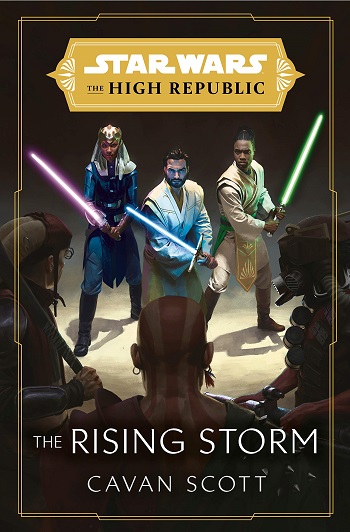
Wave two of the High Republic series revolves around the centerpiece of the Republic Fair, modeled on the 18th-to-20th century concept of the World’s Fair. In real life, these fairs were huge expositions designed to showcase the wonders of science, technology, and the globe in an era where most of the population could only see the rest of the world through illustrations in books. Star Wars often uses the design vocabulary of real-world history and times gone past, and the world’s fair concept fits right into the idea of the Republic of yesteryear, full of innovation and optimism.
The opening wave of The High Republic showed us that despite appearances, all isn’t right with the galaxy. The second wave of novels shows us that the galaxy’s troubles are just beginning – the Republic and Jedi may blaze with light and life, but trouble is on the horizon. Cavan Scott’s The Rising Storm may just as easily have been named Before the Storm, had that name not already been taken by an existing Star Wars Legends novel.
The Rising Storm is all about the Republic Fair. Personally, I think the Republic Fair is a great concept – both in-universe and out-of-universe. In-universe, Chancellor Lina Soh has a pretty wonderful idea to unify the galaxy and showcase the benefits of the shared galactic government through a showcase of shared science and culture – but was this really the right time? Out-of-universe, putting the real-world idea of a global exposition into Star Wars was an inspired idea – but is the idea used to its full potential?
I think the answer is “mostly”, but there are some avenues I wish the story had explored to make the High Republic setting seem more interesting. The in-universe shortcomings of the fair – that it might not be the best time – are actually great for the story! But there are some ideas that aren’t raised in-universe, which makes me a little disappointed. Don’t get me wrong, I still think the Republic Fair is a marvelous idea and I enjoyed The Rising Storm for the most part! My excitement is just tempered slightly by roads not trodden that would have made better use of the High Republic – and I won’t beat around the bush, it has a lot to do with the fact that the real-life World’s Fairs were also in the shadow of a gilded age of industry and colonialism and we see little sign of that in The Rising Storm. Maybe that’s not the story they set out to tell – but it’s an unfortunate omission.
Read More



